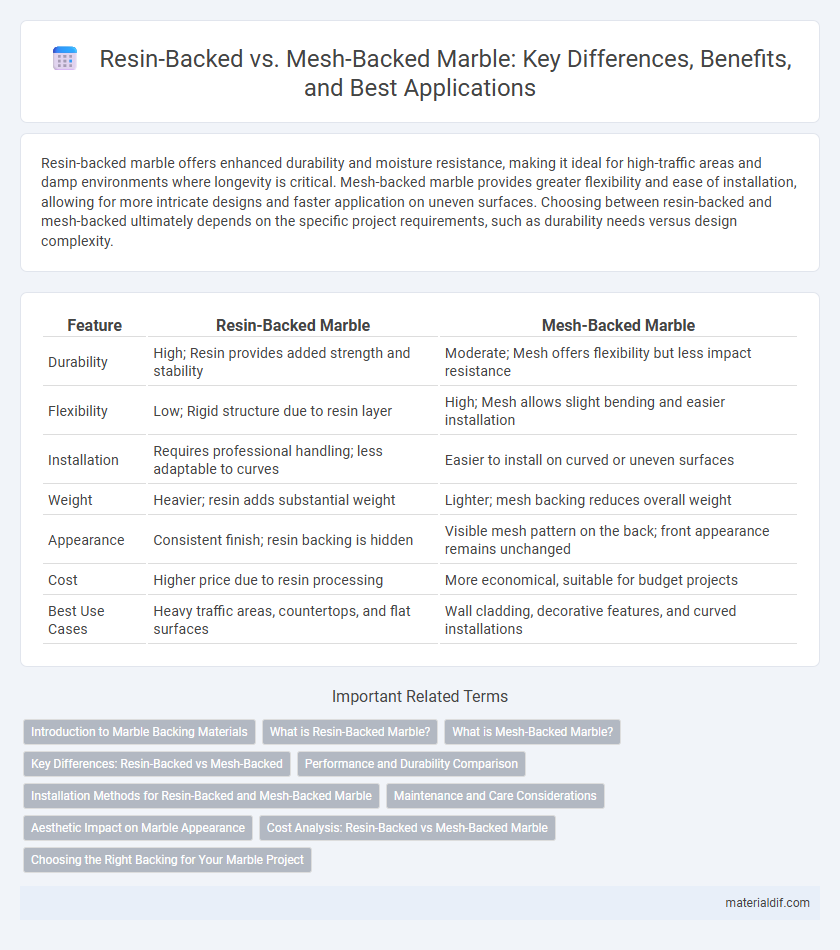Resin-backed marble offers enhanced durability and moisture resistance, making it ideal for high-traffic areas and damp environments where longevity is critical. Mesh-backed marble provides greater flexibility and ease of installation, allowing for more intricate designs and faster application on uneven surfaces. Choosing between resin-backed and mesh-backed ultimately depends on the specific project requirements, such as durability needs versus design complexity.
Table of Comparison
| Feature | Resin-Backed Marble | Mesh-Backed Marble |
|---|---|---|
| Durability | High; Resin provides added strength and stability | Moderate; Mesh offers flexibility but less impact resistance |
| Flexibility | Low; Rigid structure due to resin layer | High; Mesh allows slight bending and easier installation |
| Installation | Requires professional handling; less adaptable to curves | Easier to install on curved or uneven surfaces |
| Weight | Heavier; resin adds substantial weight | Lighter; mesh backing reduces overall weight |
| Appearance | Consistent finish; resin backing is hidden | Visible mesh pattern on the back; front appearance remains unchanged |
| Cost | Higher price due to resin processing | More economical, suitable for budget projects |
| Best Use Cases | Heavy traffic areas, countertops, and flat surfaces | Wall cladding, decorative features, and curved installations |
Introduction to Marble Backing Materials
Marble backing materials primarily include resin-backed and mesh-backed types, each offering distinct benefits for durability and installation. Resin-backed marble features a synthetic resin layer that enhances strength and simplifies cutting, making it ideal for high-traffic areas. Mesh-backed marble uses fiberglass mesh to provide flexibility and stability, facilitating easier handling and reducing the risk of cracking during installation.
What is Resin-Backed Marble?
Resin-backed marble features a durable synthetic resin layer applied to the stone's backside, enhancing its strength and preventing breakage during handling and installation. This backing provides increased stability, making resin-backed marble ideal for thin, fragile slabs used in countertops, wall cladding, and flooring. Compared to mesh-backed marble, resin-backed variants offer superior resistance to moisture and better structural integrity in demanding environments.
What is Mesh-Backed Marble?
Mesh-backed marble features a thin layer of natural marble adhered to a fiberglass mesh, enhancing durability and flexibility compared to traditional resin-backed slabs. This structure allows for easier installation on curved surfaces and reduces the risk of cracking or breaking. Architects and designers favor mesh-backed marble for its lightweight properties combined with authentic stone aesthetics, making it ideal for intricate or large-scale applications.
Key Differences: Resin-Backed vs Mesh-Backed
Resin-backed marble features a synthetic resin backing that enhances flexibility and reduces the risk of breakage, making it ideal for applications requiring intricate cuts or curves. Mesh-backed marble uses fiberglass mesh for added strength and stability, providing better support for large, flat surfaces and reducing installation time. The choice between resin-backed and mesh-backed marble depends on project requirements such as flexibility, durability, and ease of handling during installation.
Performance and Durability Comparison
Resin-backed marble offers enhanced structural stability with superior resistance to cracking, making it ideal for areas with moderate stress and temperature fluctuations. Mesh-backed marble provides increased flexibility and ease of installation but may be more prone to delamination over time under heavy use or moisture exposure. Performance-wise, resin backing excels in durability and long-term resilience, while mesh backing favors adaptability and surface conformity.
Installation Methods for Resin-Backed and Mesh-Backed Marble
Resin-backed marble features a solid acrylic resin layer that simplifies handling and allows for direct adhesive installation without extra support, making it ideal for vertical surfaces. Mesh-backed marble uses a fiberglass mesh that requires careful alignment during installation and often needs a setting bed for enhanced stability on walls and floors. Both methods demand surface preparation, but resin-backed tiles generally reduce installation time due to their rigidity and ease of application.
Maintenance and Care Considerations
Resin-backed marble offers enhanced durability and resistance to moisture, making it easier to clean and maintain in high-traffic or damp environments compared to mesh-backed marble. Mesh-backed marble requires more careful handling during cleaning to avoid damage to the mesh reinforcement, which can compromise the stone's integrity over time. Regular sealing is essential for both types, but resin-backed marble generally demands less frequent maintenance due to its improved stability and moisture resistance.
Aesthetic Impact on Marble Appearance
Resin-backed marble offers a smooth, uniform appearance that enhances the stone's natural veining and color, creating a sleek, polished look ideal for contemporary designs. Mesh-backed marble provides more flexibility, allowing the stone to be applied to curved surfaces while maintaining its visual texture and depth. Both backing types influence the overall aesthetic by supporting the stone's natural beauty, but resin backing tends to emphasize a cleaner finish, whereas mesh backing preserves a more traditional, textured look.
Cost Analysis: Resin-Backed vs Mesh-Backed Marble
Resin-backed marble generally incurs higher initial costs due to the durable resin adhesive layer, offering enhanced strength and moisture resistance, which reduces long-term maintenance expenses. Mesh-backed marble provides a more cost-effective option upfront but may require additional repairs or replacements over time due to lower durability and increased susceptibility to damage. Evaluating resin-backed versus mesh-backed marble involves balancing upfront investment against potential lifecycle costs related to durability, installation, and maintenance needs.
Choosing the Right Backing for Your Marble Project
Resin-backed marble offers enhanced moisture resistance and structural stability, making it ideal for areas prone to water exposure like bathrooms and kitchens. Mesh-backed marble provides greater flexibility and ease of installation for curved surfaces or intricate designs, suitable for decorative wall applications. Evaluating the project's environment and installation requirements ensures selecting the appropriate backing that maintains marble's durability and aesthetic appeal.
Resin-backed vs Mesh-backed Infographic

 materialdif.com
materialdif.com